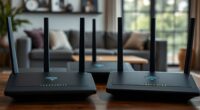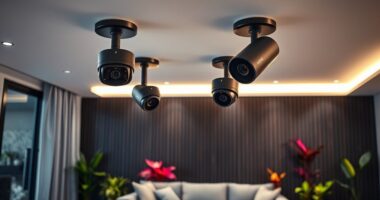Looking for the best smart home hubs to streamline your connected life in 2025? I recommend options that support multiple protocols like Zigbee, Thread, Matter, and Wi-Fi 6, ensuring broad device compatibility. Devices like the Aqara Smart Hub M100 and Amazon Echo Show 15 stand out for their features and ecosystem integration. Choosing the right hub depends on your needs for security, expandability, and ease of setup. Keep exploring, and you’ll discover how to create a seamless smart home experience.
Key Takeaways
- Look for hubs supporting multiple protocols like Zigbee, Thread, Matter, and Wi-Fi 6 for broad device compatibility.
- Choose hubs compatible with major ecosystems such as Apple HomeKit, Alexa, and Google Home for seamless integration.
- Consider ease of setup, user experience, and design features like compact size or large displays for flexible placement.
- Prioritize security features like WPA3 encryption, local automation storage, and privacy controls for safer use.
- Evaluate expandability and storage options to ensure your smart home system can grow and maintain performance over time.
AOSU Wireless Outdoor Solar Security Cameras (2 Pack)
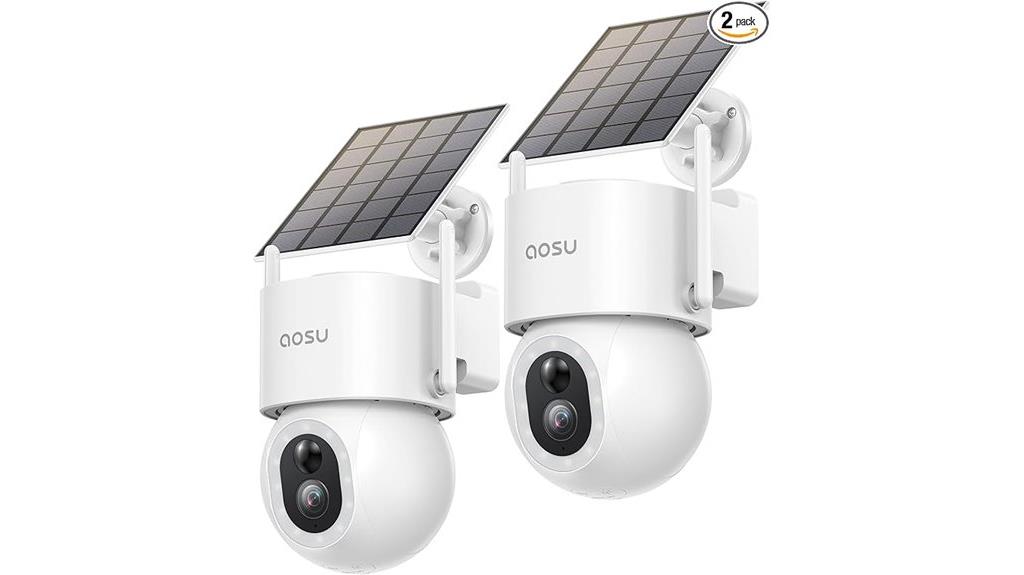
If you’re looking for an easy-to-install outdoor security solution that offers all-encompassing coverage, the AOSU Wireless Outdoor Solar Security Cameras (2 Pack) are an excellent choice. These cameras provide 360° panoramic views with 3K, 5MP UHD resolution, delivering clear, detailed images day and night. They feature color night vision, motion tracking, and support two-way talk. Wireless and solar-powered, setup is quick—just a few screws and the AOSU app. Compatible with Alexa, Google Assistant, and smartphones, they support local microSD storage and cloud options. With waterproof design and AI detection, they’re perfect for thorough, maintenance-free outdoor surveillance.
Best For: homeowners seeking an easy-to-install, maintenance-free outdoor security system with comprehensive coverage and clear, detailed imagery.
Pros:
- Easy setup with wireless, solar-powered design and quick installation via the AOSU app
- 360° panoramic coverage with 3K, 5MP UHD resolution and color night vision for detailed monitoring
- Intelligent AI detection and motion tracking that accurately identifies humans, vehicles, and pets without subscription fees
Cons:
- Occasional false alarms from background movement due to high sensitivity
- Some users report sluggish app performance and pop-up ads during use
- Battery drain issues have been noted, requiring attention or support for optimal operation
Honeywell Home T9 WiFi Smart Thermostat
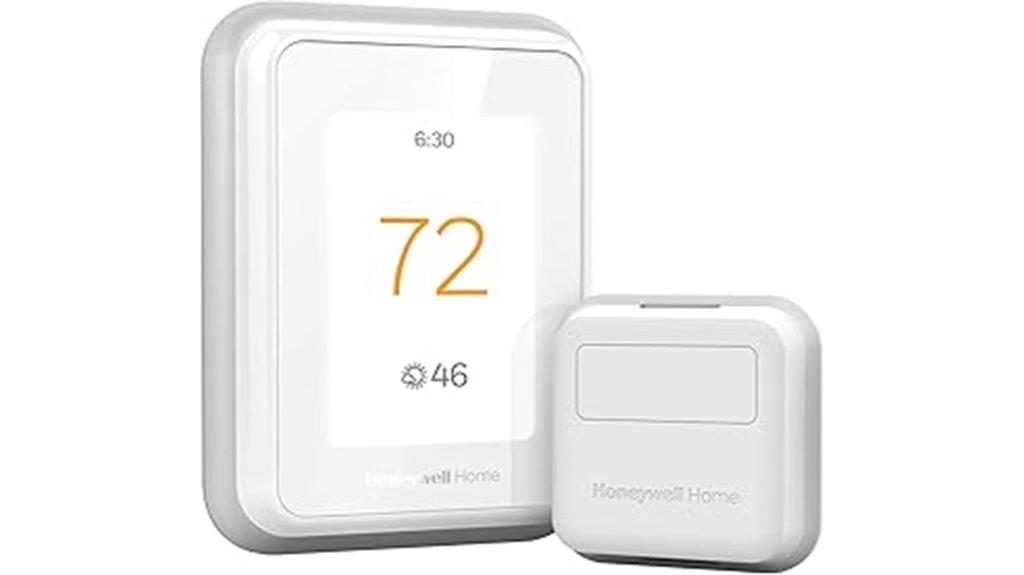
Looking for a smart thermostat that offers precise multi-room control and easy DIY installation? The Honeywell Home T9 WiFi Smart Thermostat fits the bill. It features a touchscreen display, built-in speaker, and works with the Resideo app, Alexa, Apple HomeKit, and Google Assistant. With one Smart Room Sensor included, you can monitor temperature and humidity in different rooms and create balanced comfort. It’s compatible with various HVAC systems, including forced air, hot water, steam, and heat pumps. Powered by batteries, it’s easy to install, even without a C-wire, thanks to the included power adapter. Overall, it’s a flexible and energy-efficient choice for modern smart homes.
Best For: homeowners seeking precise multi-room climate control with easy DIY installation and smart home integration.
Pros:
- Flexible multi-room control with included and additional sensors for balanced comfort.
- Easy to install without professional help, thanks to the DIY setup and power adapter for homes without C-wire.
- Compatible with popular voice assistants and smart home platforms like Alexa, Apple HomeKit, and Google Assistant.
Cons:
- Higher cost compared to basic thermostats, especially with additional sensors.
- Wi-Fi connectivity issues may occur with 5GHz networks, requiring firmware updates.
- Limited instruction guidance for sensor setup, with sensors potentially falling off if only taped.
Amazon Echo Hub 8” Smart Home Control Panel with Alexa
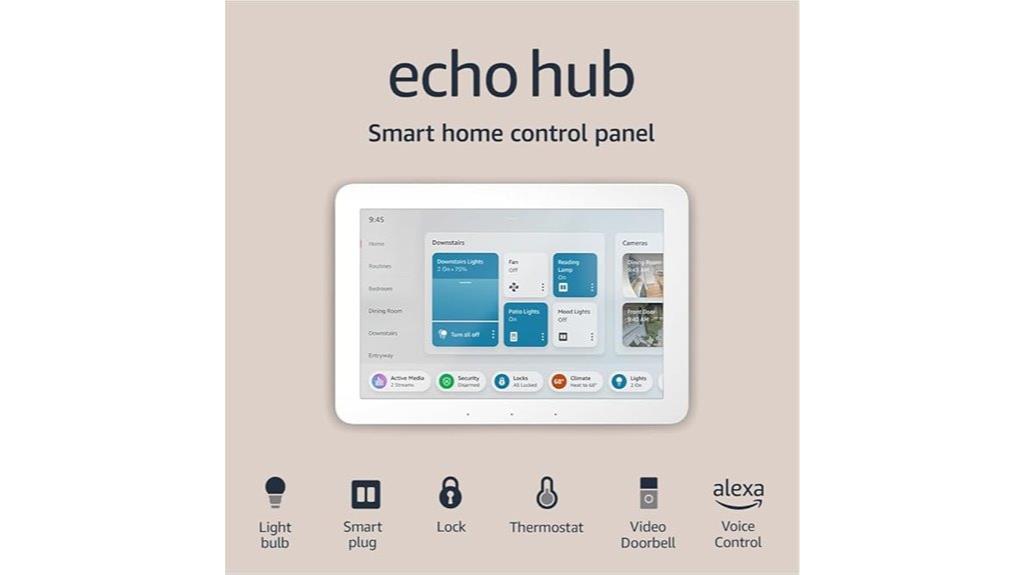
The Amazon Echo Hub 8” Smart Home Control Panel with Alexa is an excellent choice for those who want a sleek, wall-mounted device to easily manage their smart home ecosystem. It features an 8-inch touch screen with high-resolution display, supporting WiFi, Bluetooth, Zigbee, Thread, and Matter devices. You can control lights, locks, cameras, and thermostats remotely, customize controls, and view security feeds effortlessly. With built-in sensors, privacy features, and adaptive accessibility options, it offers a modern, streamlined experience. While it’s not ideal for media or complex automation, it’s perfect for quick device access, routines, and integrating your existing smart home setup.
Best For: homeowners and smart home enthusiasts seeking a sleek, wall-mounted control panel for quick access to and management of their smart devices without the need for complex automation or media streaming.
Pros:
- Easy-to-use 8” high-resolution touch screen with customizable controls
- Supports a wide range of smart home protocols including Zigbee, Thread, and Matter
- Privacy features like microphone off buttons and streaming indicators
Cons:
- Limited customization options and no support for device groups or multi-device control
- Less smooth interface compared to high-end tablets, with occasional stuttering
- Not suitable for media consumption or managing detailed device settings
Amazon Echo Show 8 (Newest Model) with Alexa and Smart Home Hub
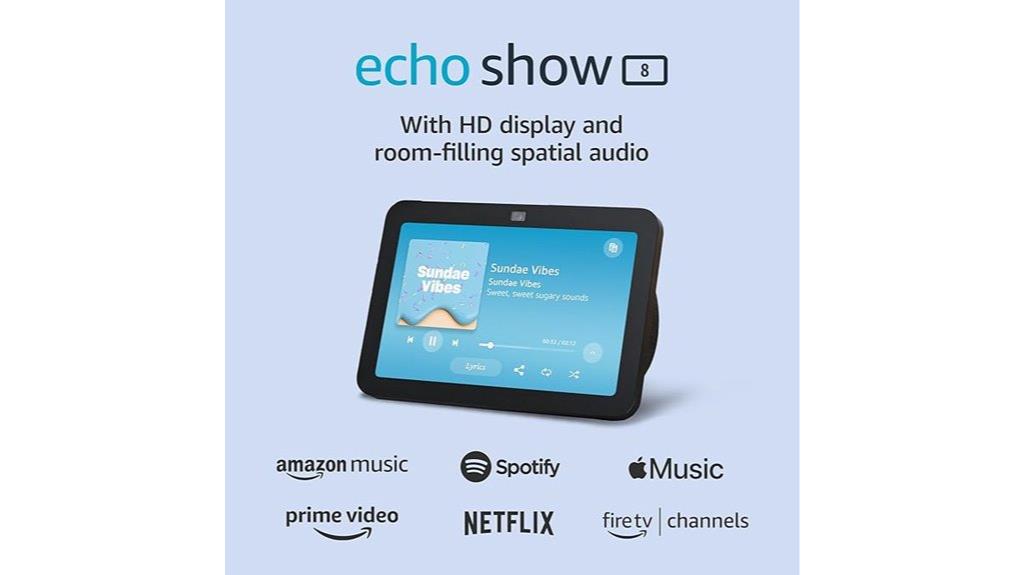
Anyone seeking a seamless smart home experience should consider the Amazon Echo Show 8 with built-in hub support. This 2023 model features an 8-inch HD touchscreen with vibrant visuals and adaptive color, perfect for kitchens or bedrooms. Its sleek design, made from recycled materials, combines style with sustainability. The device’s built-in Zigbee, Matter, and Thread protocols let you control compatible smart devices without extra hubs. With immersive sound, high-quality video calls, and easy setup via Amazon’s WiFi, it’s a versatile control center. Alexa’s voice control, privacy features, and accessibility options make it user-friendly, ensuring your connected home is simple, secure, and integrated.
Best For: individuals seeking an all-in-one smart home hub with high-quality visuals, immersive sound, and accessible voice control, ideal for kitchens, bedrooms, or living spaces.
Pros:
- Built-in Zigbee, Matter, and Thread protocols for easy smart device integration without extra hubs
- High-resolution 8-inch HD touchscreen with adaptive color for vibrant visuals in any lighting
- Robust privacy features including camera shutter, microphone mute, and voice recording management
Cons:
- Default home screen ads may require adjustments to minimize interruptions
- Slight learning curve for new users unfamiliar with smart home automation features
- Limited to English and Spanish language support, which may not suit all users
Home Assistant Green Smart Home Hub
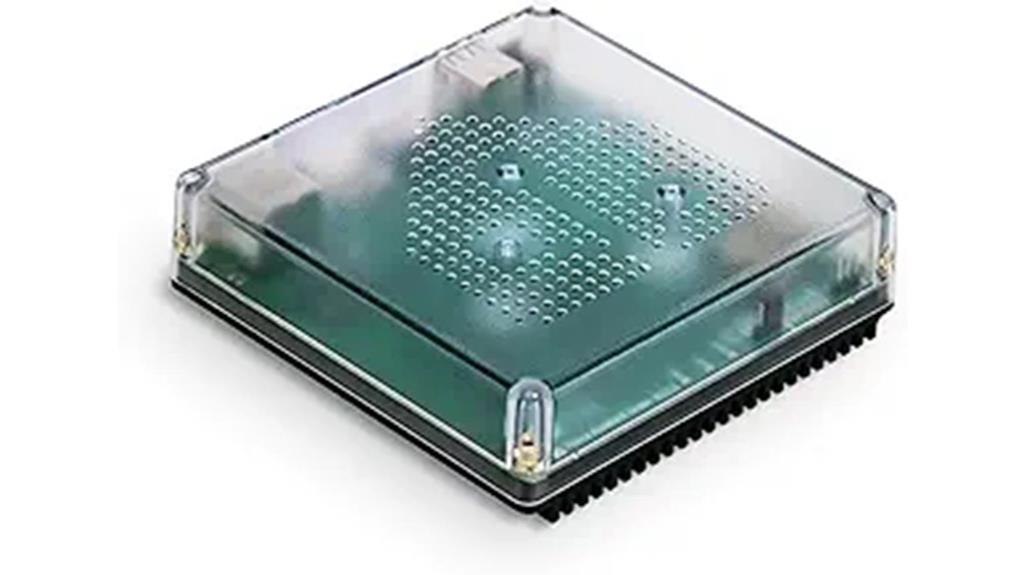
If you’re seeking a compact, reliable smart home hub that offers quick setup and local control, Home Assistant Green is an excellent choice. This official, fanless device is small, lightweight, and supports Zigbee, Z-Wave, and Thread protocols, making it versatile for various smart devices. It features a quad-core processor, 32GB storage, and 4GB RAM, ensuring smooth automation. Setup is simple—just plug in, connect via Ethernet, and install Home Assistant. Its silent operation and expandability via USB ports make it unobtrusive and adaptable. Highly rated and supported by an active community, Green provides a robust, future-proof platform for both beginners and experienced users.
Best For: those seeking a compact, reliable, and versatile smart home hub with easy setup and local control capabilities.
Pros:
- Supports multiple protocols including Zigbee, Z-Wave, and Thread for broad device compatibility
- Easy plug-and-play installation suitable for both beginners and advanced users
- Silent operation with robust performance powered by a quad-core processor and ample storage
Cons:
- USB port placement may require extension cables due to proximity to the power port
- Some advanced configurations may have a learning curve and require familiarity with smart home principles
- Limited expandability beyond USB connections and initial hardware specifications
SmartThings Hub 3rd Generation Smart Home Automation Hub

For those seeking a versatile and reliable smart home hub, the SmartThings Hub 3rd Generation stands out by supporting multiple wireless protocols like Zigbee, Z-Wave, Wi-Fi, and Ethernet. This broad compatibility lets me connect a wide range of devices, from Philips Hue lights to thermostats and smart plugs, all centralized for seamless control. Setting it up is quick—pairing devices takes about 15 minutes with app guidance. Once connected, I can automate routines, control devices via voice or app, and enjoy real-time responses without relying solely on cloud services. Its wall-mountable design and local communication guarantee reliable, fast operation, making my smart home smarter and more integrated.
Best For: homeowners and tech enthusiasts seeking a versatile, reliable smart home hub that supports multiple protocols and integrates a wide range of compatible devices.
Pros:
- Supports multiple wireless protocols (Zigbee, Z-Wave, Wi-Fi, Ethernet) for broad device compatibility.
- Easy and quick setup with app-guided pairing, typically within 15 minutes.
- Enables local control and automation, reducing reliance on cloud services for faster responses.
Cons:
- No included batteries, requiring users to supply their own power adapter.
- Some older or specific third-party devices may need custom handlers or additional configuration during migration.
- The IP54 rating offers limited water resistance, not suitable for outdoor placement in harsh conditions.
REOLINK Wireless Outdoor Security Cameras with Solar Panel
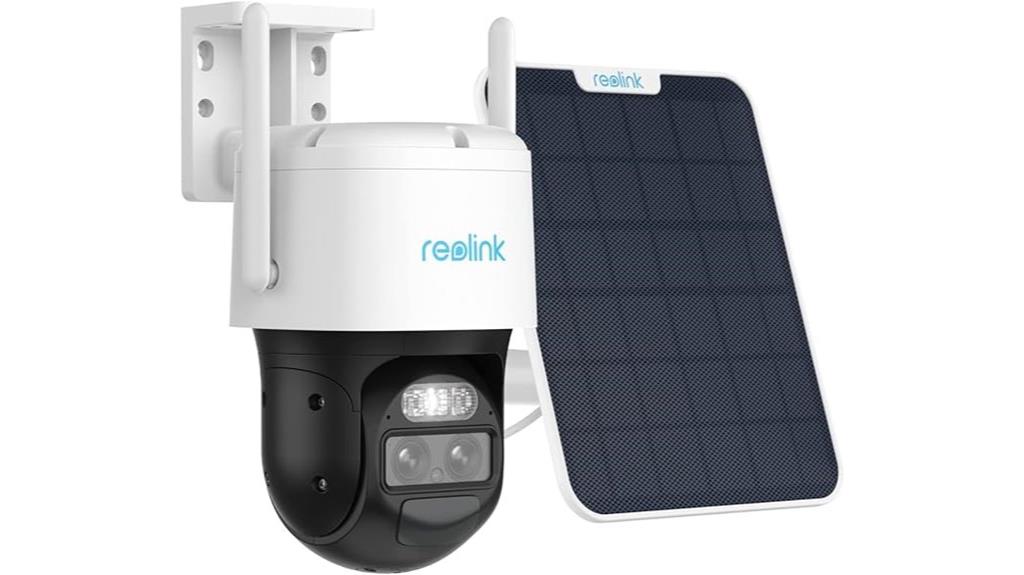
The REOLINK Wireless Outdoor Security Cameras with Solar Panel are an excellent choice for those seeking reliable, maintenance-free surveillance. They feature dual lenses—wide-angle and telephoto—that provide both full views and close-ups simultaneously. With 2K color night vision and 6X hybrid zoom, you get clear, detailed footage even in low light. The cameras automatically track movement, panning up to 355° and tilting 90°, following subjects in real-time. Powered by a 6W solar panel and rechargeable battery, they require no charging. Waterproof and durable, they’re built for year-round outdoor use, offering accurate alerts and flexible local storage options.
Best For: Homeowners and property managers seeking reliable, maintenance-free outdoor security with advanced features and flexible storage options.
Pros:
- Dual lenses providing simultaneous full-view and close-up footage for comprehensive monitoring.
- 2K color night vision and 6X hybrid zoom deliver clear, detailed images in low light conditions.
- Auto tracking with 355° pan and 90° tilt ensures thorough coverage and real-time subject following.
Cons:
- MicroSD cards up to 128GB are required for local storage, which may involve additional cost.
- The camera setup and configuration might be complex for less tech-savvy users.
- The effectiveness of solar charging depends on sufficient sunlight exposure.
Lutron Caseta Smart Lighting Hub for Light Bulbs and Fans
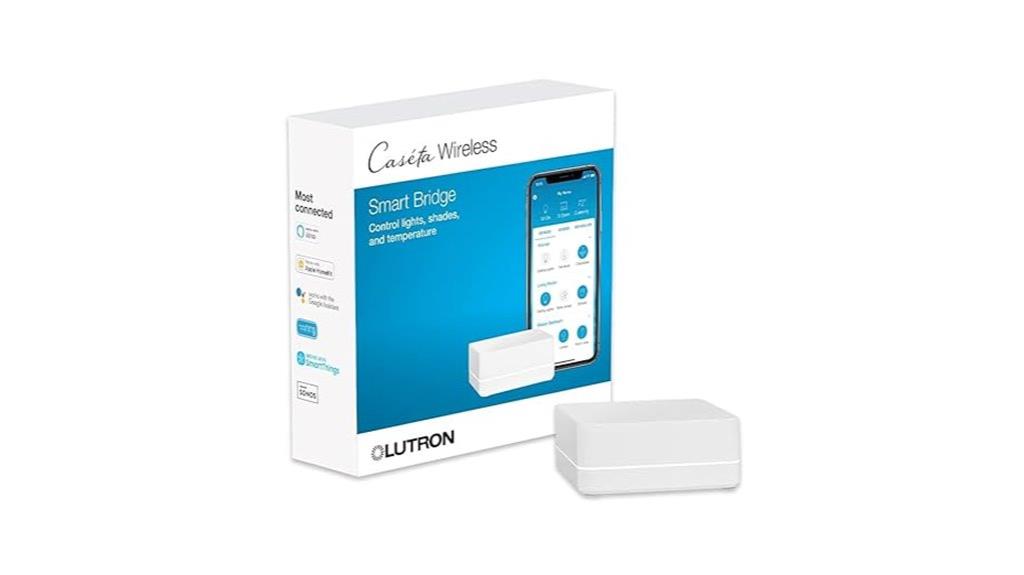
The Lutron Caseta Smart Lighting Hub stands out as an excellent choice for homeowners seeking a reliable and straightforward way to control their lights, shades, and temperature from a single device. It supports up to 75 devices and works well with major ecosystems like Alexa, Apple HomeKit, and Google Assistant. Installation is simple—just connect it to Wi-Fi, plug it in, and follow the app instructions. It offers features like scheduling, scenes, and geo-fencing for automation. While it’s easy to set up and affordable, some brands like Leviton require extra accessories for full compatibility. Overall, it’s a dependable, user-friendly hub for smart lighting and shades.
Best For: homeowners seeking an affordable, easy-to-install smart hub for reliable control of lighting, shades, and temperature compatible with major voice assistants and ecosystems.
Pros:
- Simple setup with straightforward app instructions and reliable operation
- Compatible with Amazon Alexa, Apple HomeKit, and Google Assistant for seamless voice control
- Supports up to 75 devices, allowing scalable home automation
Cons:
- Limited native compatibility with brands like Leviton without additional accessories
- Requires a wired network connection, as it does not support Wi-Fi directly
- Some users have reported receiving pre-owned units, which may concern new buyers
Aqara Smart Hub M2 for Home Automation
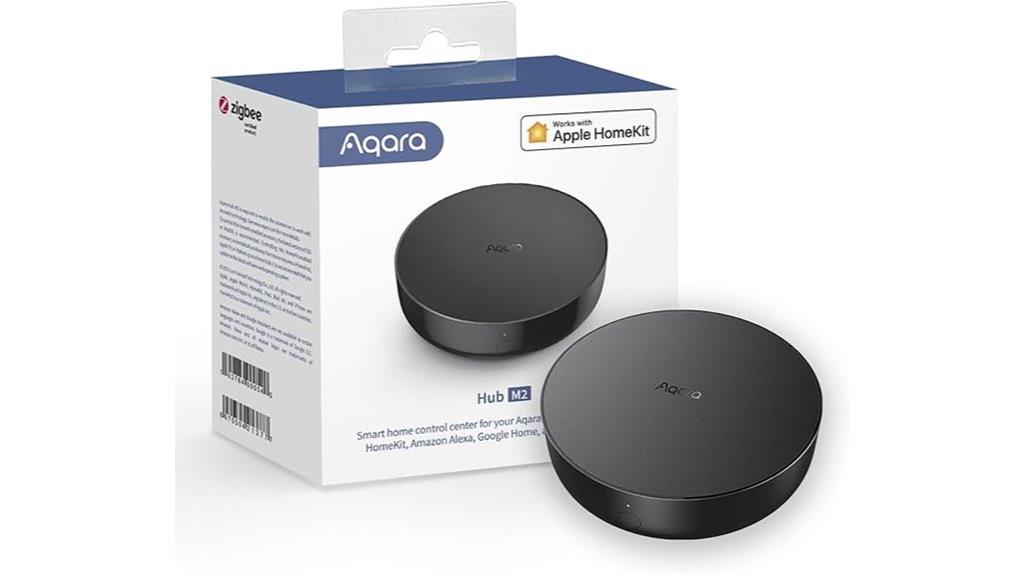
Looking for a smart home hub that seamlessly integrates multiple ecosystems and supports a large number of Zigbee devices? The Aqara Smart Hub M2 might be just what you need. It supports Wi-Fi, Zigbee 3.0, Apple HomeKit, Alexa, Google Assistant, and IFTTT, connecting up to 128 Aqara Zigbee devices. Its compact design includes IR remote control, a built-in speaker for alerts, and LAN connectivity for quick responses. While setup is quick, some users find device binding and configuration a bit tricky. The hub excels at automation, scene creation, and voice control, making it a solid choice for expanding or starting a smart home system.
Best For: users seeking a versatile, multi-ecosystem smart home hub that can connect numerous Zigbee devices and supports voice control, automation, and IR remote functions.
Pros:
- Supports multiple ecosystems including Apple HomeKit, Alexa, Google Assistant, and IFTTT, enabling flexible integration.
- Connects up to 128 Aqara Zigbee devices, ideal for expanding a smart home setup.
- Features LAN connectivity and IR remote control for quick responses and versatile device control.
Cons:
- Setup and device binding can be cumbersome, especially when replacing or upgrading hubs.
- Lacks a power supply in the box, requiring an external USB charger for operation.
- Some users experience signal issues with certain Zigbee devices, and the built-in speaker volume may be insufficient for alerts.
Aqara Smart Hub M3 for Home Automation
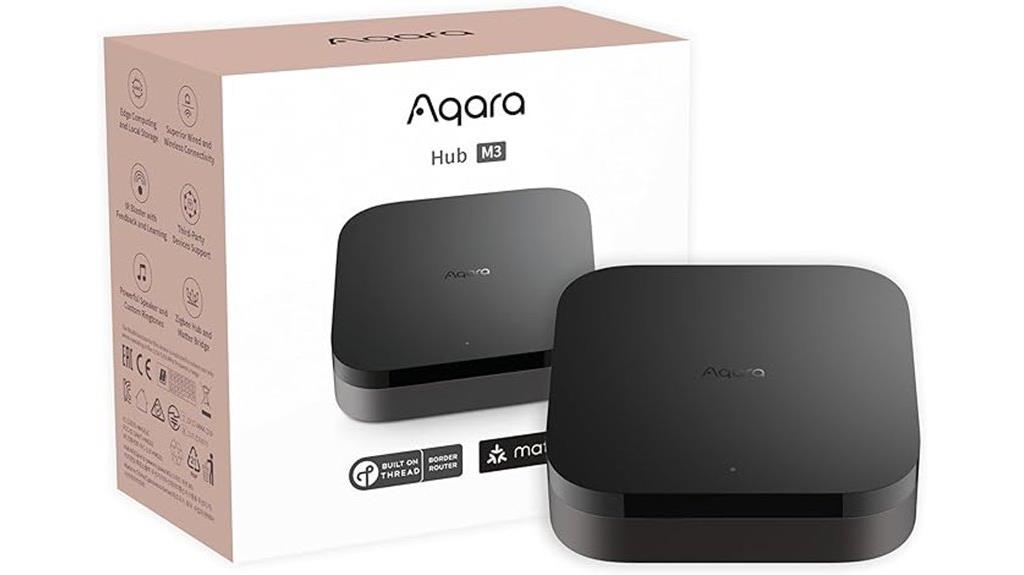
Are you seeking a smart home hub that combines broad compatibility with local control and privacy? The Aqara Smart Hub M3 fits the bill. It supports Zigbee, Thread, Wi-Fi, and Bluetooth, connecting to Aqara devices and select third-party products like Daikin air conditioners. It’s compatible with Apple HomeKit, Alexa, SmartThings, and IFTTT, ensuring seamless control across platforms. With local automation stored securely on encrypted 8GB storage, it prioritizes privacy. The M3 supports up to 127 Zigbee and Thread devices, functions as an Edge Hub, and features a smart IR blaster. Its straightforward setup and focus on stability make it a solid choice for modern smart homes.
Best For: homeowners seeking a versatile, privacy-focused smart home hub with broad ecosystem compatibility and local control capabilities.
Pros:
- Supports multiple protocols including Zigbee, Thread, Wi-Fi, and Bluetooth for extensive device integration
- Local automation stored on encrypted 8GB storage enhances privacy and stability
- Compatible with major platforms like Apple HomeKit, Alexa, SmartThings, and IFTTT for seamless control
Cons:
- Cannot directly adopt third-party Zigbee devices, requiring additional routers or extenders
- Limited compatibility with certain third-party devices such as some thermostats and remote controls
- The Aqara app interface is considered chaotic and less user-friendly, especially for multi-user setups
Google Nest Hub 7” Smart Display with Google Assistant (2nd Gen) – Chalk
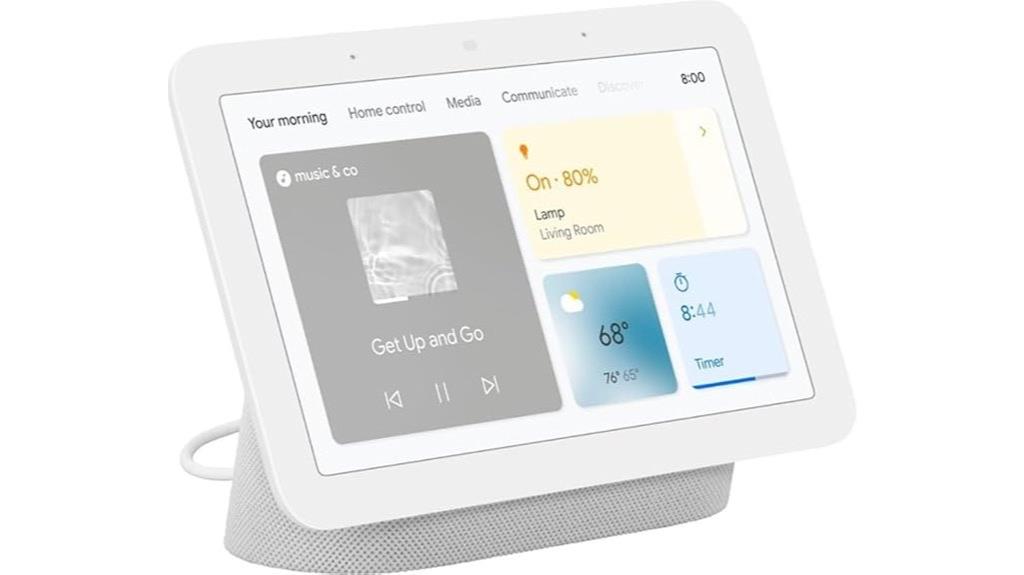
If you’re seeking an affordable yet capable smart display to control your smart home devices, the Google Nest Hub 7” (2nd Gen) with Google Assistant is an excellent choice. Its compact size and sleek chalk color help it blend seamlessly into any room, whether on a nightstand or wall-mounted. It offers bright visuals, quality sound, and easy control of compatible lights, TVs, and more via voice or touch. Plus, it supports family messaging, calls, and streaming services like YouTube and Netflix. Sleep Sensing adds health insights, while privacy features like mic off ensure peace of mind. Despite some software limitations, it’s a solid, user-friendly hub for a connected home.
Best For: those seeking an affordable, stylish, and easy-to-use smart display to control their smart home devices and enjoy media streaming.
Pros:
- Compact design with a sleek chalk finish that blends into home decor
- Bright display with quality sound for media playback and visual alerts
- Supports family messaging, calls, and sleep tracking for added convenience
Cons:
- Limited app ecosystem with no access to Google Play Store or third-party apps
- Inconsistent speaker grouping and regional functionality issues
- Setup can be problematic, sometimes starting in Mandarin or experiencing Wi-Fi connection problems
REOLINK 4K Solar Security Cameras with Pan Tilt and Auto-Tracking
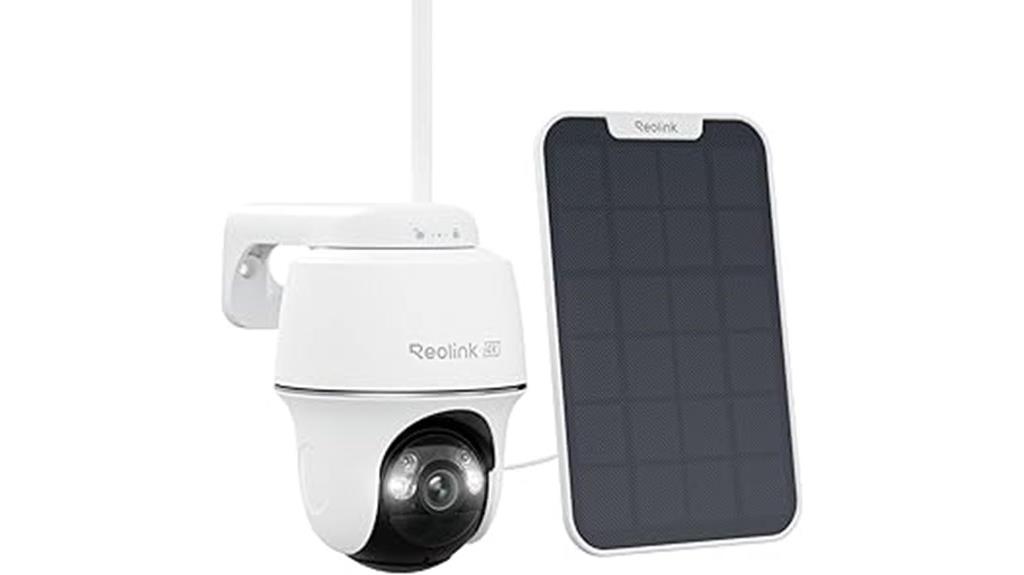
The REOLINK 4K Solar Security Camera stands out as an ideal choice for homeowners seeking a reliable, wire-free surveillance solution with all-encompassing coverage. Its 4K resolution delivers sharp, detailed images day and night, enhanced by night color technology and a built-in spotlight. With 355° pan and 140° tilt, it covers virtually every angle, and auto-tracking keeps moving objects in frame. Its solar panel guarantees eco-friendly power, while dual-band Wi-Fi makes setup simple. Easy to install with no wiring, it supports local storage and offers customizable alerts, making it a versatile, high-performance security option for any home.
Best For: homeowners seeking a high-resolution, wire-free security camera with comprehensive coverage and smart tracking capabilities.
Pros:
- 4K ultra-high definition image quality with clear day and night footage
- 360° coverage with auto-tracking to follow moving objects in real time
- Eco-friendly solar power with easy wireless installation and flexible placement options
Cons:
- May experience false alarms or detection limitations due to PIR motion sensor sensitivity and pet detection beta
- Support and warranty issues reported by some users, especially regarding replacement parts
- Pixelation can occur at night despite color night vision technology
Aqara Smart Hub M100 for Home Automation
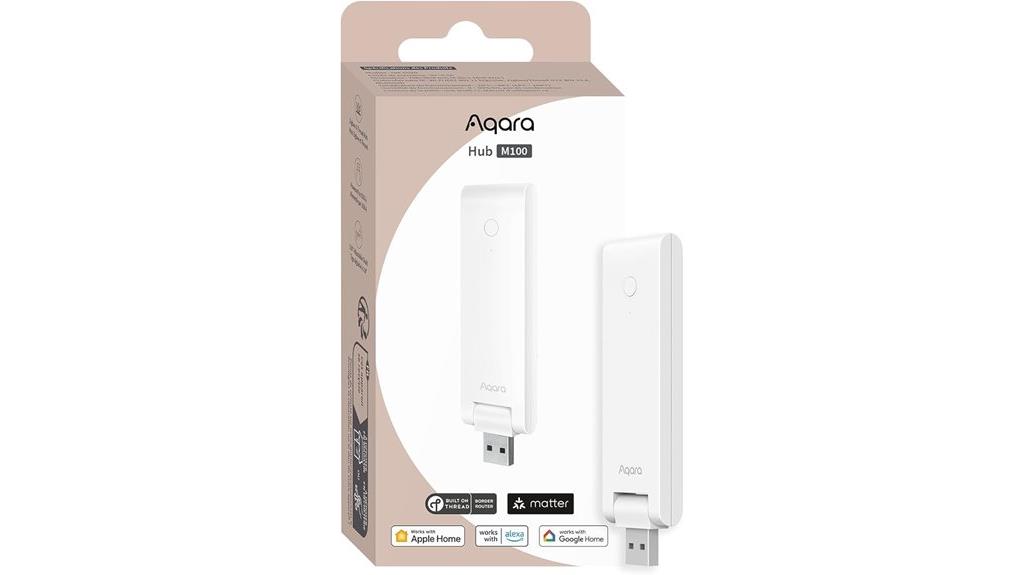
Looking for a compact, versatile hub that bridges multiple smart home ecosystems? The Aqara Smart Hub M100 fits the bill perfectly. It supports Zigbee 3.0, Thread, Matter, and Wi-Fi 6, connecting up to 20 Aqara Zigbee and Thread devices each. It acts as a Matter bridge, integrating Aqara products with Apple HomeKit, Alexa, and more. Its small size and flexible placement options make it unobtrusive, while features like local automation guarantee quick responses even without internet. Though setup can be tricky, its stability, multi-protocol support, and compatibility with various ecosystems make it a smart choice for expanding your connected home.
Best For: smart home enthusiasts seeking a compact, multi-protocol hub that integrates various ecosystems like Apple HomeKit, Alexa, and Google Home while supporting Zigbee, Thread, and Matter.
Pros:
- Supports multiple protocols including Zigbee 3.0, Thread, Matter, and Wi-Fi 6 for versatile device integration
- Acts as a Matter bridge, enabling seamless ecosystem connectivity and advanced automation features
- Compact size with flexible placement options and local automation capabilities for reliable performance
Cons:
- Setup can be complex, especially for users unfamiliar with Thread and Zigbee ecosystems
- Initial pairing issues and app usability concerns may hinder first-time configuration
- Some features, like cloud notifications, require internet access, which may impact offline automation
Amazon Echo Show 15 (Newest Model) Kitchen Hub with Fire TV & Alexa
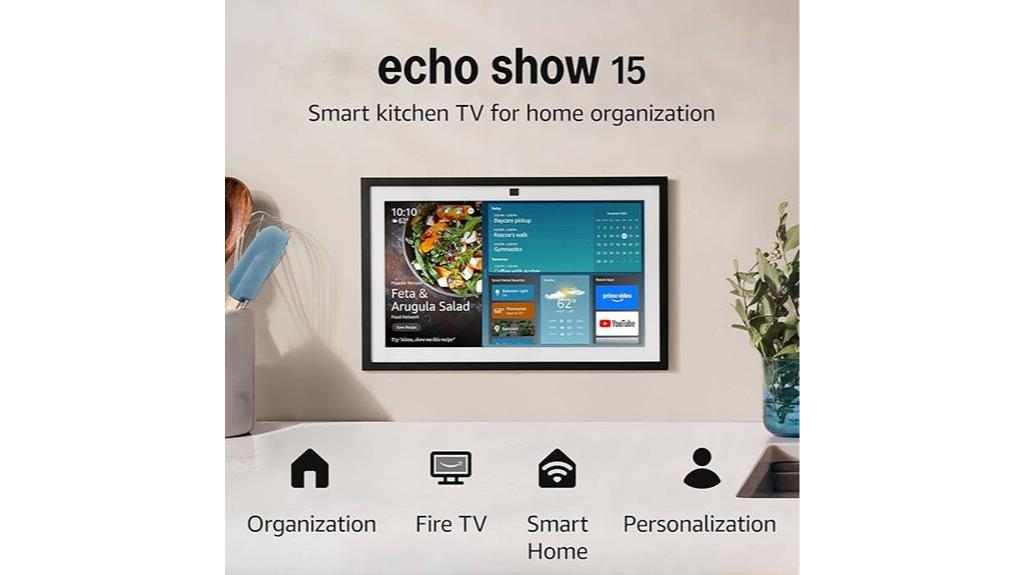
For anyone seeking a central smart home control point that doubles as an entertainment hub, the Amazon Echo Show 15 (Newest Model) Kitchen Hub with Fire TV & Alexa stands out. Its 15.6-inch Full HD display can switch between landscape and portrait modes, making it perfect for kitchens or living rooms. It features a 13 MP camera with shutter, stereo speakers, and supports Wi-Fi 6E, Zigbee, and Matter for seamless device integration. With built-in Fire TV, you get access to thousands of apps like Prime Video and Netflix. Plus, Alexa handles smart home controls effortlessly, while privacy controls and accessibility features ensure a secure, inclusive experience.
Best For: households or individuals seeking a versatile smart display that combines entertainment, smart home control, and video calling with enhanced privacy and accessibility features.
Pros:
- Large 15.6-inch Full HD display with flexible orientation options for versatile use.
- Seamless integration with smart home devices via Zigbee, Matter, and Thread, acting as a central hub.
- Built-in Fire TV with access to thousands of streaming apps for entertainment in any room.
Cons:
- Premium price point may be a consideration for budget-conscious buyers.
- Requires Wi-Fi 6E and compatible smart devices for optimal performance, which might involve additional setup.
- Some users may find the array of features overwhelming if only basic functionality is desired.
Tapo Smart Home Central Hub
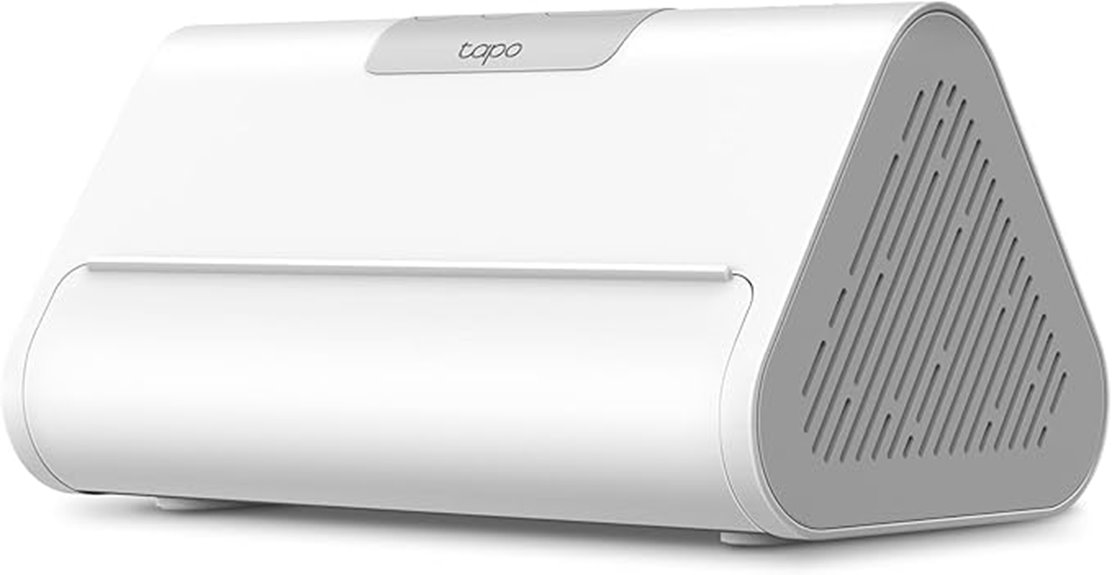
Are you seeking a centralized solution to manage multiple smart devices effortlessly? The Tapo Smart Home Central Hub is exactly that. It connects up to 16 Tapo cameras and 64 Tapo Sub-G sensors, unifying your smart home on one platform. With 16GB of built-in storage and support for a 2.5 SATA HDD or SSD, it offers unlimited recording access without subscriptions. Advanced features like facial recognition and WPA3 encryption enhance security and reduce false alerts. You can monitor live feeds via HDMI or mobile devices, and the built-in 110dB alarm adds an extra layer of security. It’s a powerful, expandable hub that simplifies managing your connected home.
Best For: homeowners and smart device enthusiasts seeking a centralized, secure, and expandable hub to manage multiple cameras and sensors seamlessly.
Pros:
- Unifies up to 16 cameras and 64 sensors on a single platform for easy management
- Supports unlimited recording with built-in storage and expandability options without subscription fees
- Features advanced security with facial recognition and WPA3 encryption to protect privacy
Cons:
- Requires additional purchase of HDD/SSD for expanded storage capacity
- Limited to Tapo device compatibility, which may restrict integration with other brands
- No mention of built-in Wi-Fi, potentially necessitating additional networking setup
Factors to Consider When Choosing Smart Home Hubs
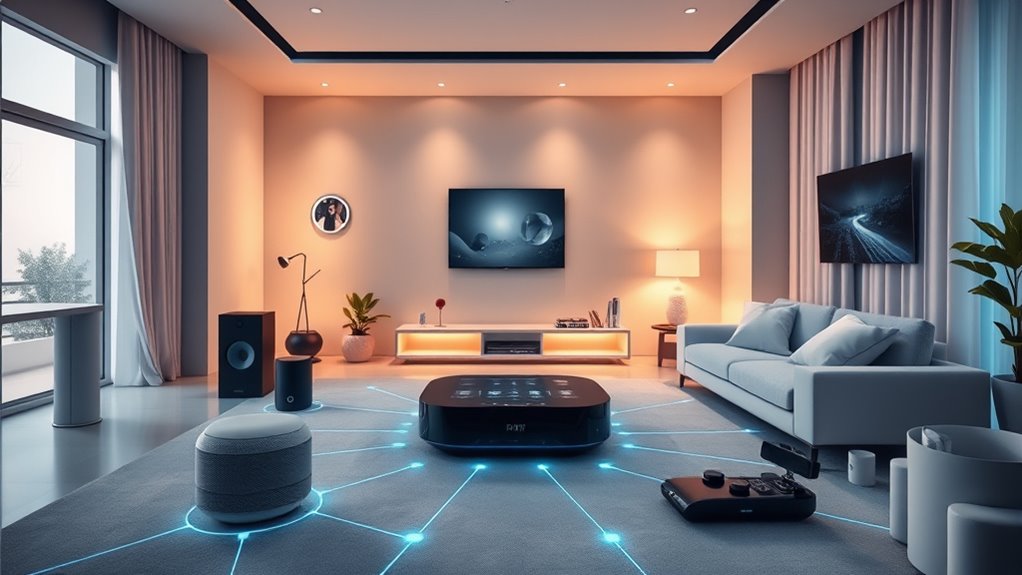
When selecting a smart home hub, I examine how effectively it functions with my current devices and the protocols it supports. Ease of installation and automation capabilities are also important, since I want things to be straightforward and adaptable. Finally, I consider how effortlessly it integrates with my ecosystem to guarantee everything operates together smoothly.
Compatibility With Devices
Choosing the right smart home hub depends heavily on its compatibility with your existing devices and ecosystems. You need to guarantee the hub supports the wireless protocols your devices use, like Zigbee, Z-Wave, Thread, or Wi-Fi, for smooth communication. It’s also important to verify that the hub works with your specific brands and models, whether it’s Aqara, Philips Hue, or Samsung SmartThings. Additionally, check if it integrates with your preferred voice assistants such as Alexa, Google Assistant, or Apple HomeKit, to enable voice control. Consider whether the hub supports both native device control and third-party integrations, especially if you plan to expand later. Finally, make sure it’s compatible with local automation features and protocols like Matter to future-proof your setup.
Protocol Support Options
Selecting a smart home hub requires careful attention to the protocols it supports, as these determine which devices can connect and communicate effectively. Different hubs support protocols like Zigbee, Z-Wave, Wi-Fi, Thread, and Bluetooth, shaping device compatibility and network flexibility. Having support for multiple protocols in one hub allows you to integrate a broader range of smart devices without needing multiple controllers. Protocol compatibility also impacts network reliability, response speed, and security—some protocols are faster and more secure than others. Additionally, advanced protocols like Matter are gaining popularity because they aim to unify device communication standards across ecosystems, enhancing compatibility. When choosing a hub, guarantee it supports the protocols your existing or planned devices use for seamless integration and optimal performance.
Ease of Setup
A smart home hub that’s easy to set up can save you time and frustration, especially if you’re new to home automation. Look for hubs with guided setup processes that can be completed in 30 minutes or less. Clear instructions, visual aids, or QR codes make pairing devices straightforward and reduce errors. Wireless installation options like Wi-Fi or Bluetooth eliminate the need for complicated wiring or professional help, making setup more accessible. Compatibility with mobile apps that support step-by-step configuration simplifies both initial setup and ongoing control. Additionally, hubs that support automatic device detection and plug-and-play pairing substantially cut down setup time, helping you get your smart home running smoothly without hassle. Ease of setup is essential for a stress-free smart home experience.
Automation Capabilities
When evaluating smart home hubs, it’s essential to take into account their automation capabilities to guarantee they meet your needs. I look for hubs that support multi-protocol automation like Zigbee, Z-Wave, Thread, or Wi-Fi, ensuring compatibility with a wide range of devices. The ability to create complex routines with conditional triggers and scene settings adds significant flexibility and customization. Local automation processing is a big plus, offering faster responses and better privacy by reducing reliance on cloud services. Integration with voice assistants like Alexa, Google Assistant, or Siri allows for effortless voice commands and scene control. Finally, regular firmware and software updates keep automation features current, secure, and compatible with future smart home standards.
Ecosystem Integration
Ecosystem integration plays a vital role in ensuring your smart home hub can connect smoothly with various devices and platforms. A well-integrated hub communicates effortlessly within ecosystems like Apple HomeKit, Google Home, or Amazon Alexa, giving you more control. Compatibility with multiple ecosystems means you can manage devices from different brands without hassle, making your setup flexible and future-proof. Support for standardized protocols like Zigbee, Z-Wave, Thread, and Matter is essential for enabling devices to work together, regardless of brand. An ideal hub offers a unified app or interface, simplifying device management and automations across ecosystems. Your choice of a hub with strong ecosystem integration impacts voice control options, automation, and overall system cohesion, making your smart home more seamless and responsive.
Security and Privacy
Choosing a smart home hub requires careful attention to security and privacy features that safeguard your data and devices. I look for hubs that use strong encryption protocols like WPA3 or end-to-end encryption to protect my communications. Physical privacy controls, such as microphone and camera shutters or mute switches, are also essential to prevent unauthorized recordings. I verify that the hub receives regular security updates and firmware patches, ensuring vulnerabilities are addressed promptly. Storing sensitive data locally rather than relying solely on cloud services reduces exposure to breaches. Finally, I review the manufacturer’s privacy policy to confirm that my personal information and device activity aren’t shared or sold without my consent. Prioritizing these factors helps me maintain control over my connected home’s security and privacy.
Expandability and Futureproofing
Security and privacy are essential, but guaranteeing your smart home hub can grow with your needs matters just as much. A futureproof hub should support multiple protocols like Zigbee, Z-Wave, Thread, and Wi-Fi to stay compatible as new devices emerge. Expandability features such as USB ports, module slots, or support for third-party integrations let you upgrade without replacing the entire system. Compatibility with standards like Matter ensures your hub can connect to future devices and ecosystems, protecting your investment. Being able to connect to multiple smart home platforms like Apple HomeKit, Alexa, or Google Assistant via bridging or native support increases flexibility. A modular design or software updates that add new functionalities help extend the hub’s lifespan, adapting to evolving technology and your growing smart home.
Frequently Asked Questions
How Do Smart Hubs Ensure Data Privacy and Security?
Smart hubs prioritize data privacy and security by encrypting your information, making it unreadable to outsiders. They also implement strict access controls, ensuring only authorized devices can connect. Regular firmware updates patch vulnerabilities, while robust authentication methods, like two-factor authentication, add extra layers of protection. I always recommend choosing hubs with transparent privacy policies and strong security features to keep your connected home safe and private.
Can Multiple Smart Hubs Operate Seamlessly Together?
Absolutely, multiple smart hubs can work seamlessly together if they’re compatible and connected through a unified platform or standard like Zigbee or Z-Wave. I make sure my hubs support common protocols, which helps devices communicate smoothly. This setup allows me to control different systems from a single app or voice assistant, creating a more integrated and efficient smart home experience.
What Is the Typical Setup Time for a New Smart Home Hub?
Setting up a new smart home hub usually takes me about 15 to 30 minutes, depending on how many devices I plan to connect. I start by plugging it in, downloading the app, and following the on-screen instructions. Sometimes I need to do a firmware update or reconnect devices, which can add a few extra minutes. Overall, it’s a straightforward process that quickly gets my smart home up and running.
How Do Smart Hubs Handle Firmware Updates and Maintenance?
Smart hubs handle firmware updates automatically or manually, depending on your preference. I usually opt for automatic updates because they run quietly in the background, ensuring my system stays secure and efficient. Sometimes, I check for updates manually through the app to see what’s new. Maintenance is generally straightforward—most hubs notify me when updates are available, making it easy to keep my smart home running smoothly without much effort.
Are Smart Hubs Compatible With All Smart Device Brands?
Imagine trying to speak multiple languages at once—that’s what compatibility feels like with smart hubs. Not all hubs support every device brand; some excel with certain ecosystems like Zigbee or Z-Wave, but might struggle elsewhere. I’ve found that choosing a hub with broad compatibility, like Samsung SmartThings, simplifies my smart home because it acts like a universal translator, making sure all my gadgets work harmoniously without fuss.
Conclusion
Choosing the right smart home hub can feel overwhelming, but it’s about balancing convenience and control. Whether you prefer a sleek touchscreen, voice assistant, or robust automation, the best hub simplifies your life. It’s like having a personal conductor for your connected devices—coordinating chaos into harmony. Ultimately, the right hub isn’t just about technology; it’s about creating a seamless, intuitive space where your home responds effortlessly to your needs.


